This month the Daring Bakers kept our creativity rolling with cinnamon bun inspired treats. Shelley from C Mom Cook dared us to create our own dough and fill it with any filling we wanted to craft tasty rolled treats, cinnamon not required! Don’t let the title “cinnamon roll” fool you. There are so many flavor possibilities at every single stage of these tasty treats – the dough, the filling and even the icing! According to Wikipedia, although cinnamon rolls are largely a North American treat, they have their origins in Sweden. These rolls generally consist of a layer of sweet, yeast-risen dough onto which a cinnamon sugar mixture is sprinkled. The dough is then rolled into a log with is cut into slices, which are baked as individual buns. In North America, the buns are generally topped with some kind of glaze or cream cheese frosting.

Cutting the buns can be a messy process if not done correctly, the filling can squish out and you can wind up with flattened or mis-shapen pieces. The two most common, successful methods of doing so are as follows: 1) A sharp, serrated knife: Use a sawing motion, carefully but firmly slice through the log. 2) Unwaxed dental floss: Cut a length of floss (you can use thread, too) to about 18-24 inches (33x 61 cm) long. Holding on to both ends, slide the middle section of the floss (thread) under the log to the location where you want to make your cut. Wrap the floss around the log like you are going to tie a knot around it, then pull the ends tightly to cut through the log; a little tip works like a charm!
CINNAMON BUNS
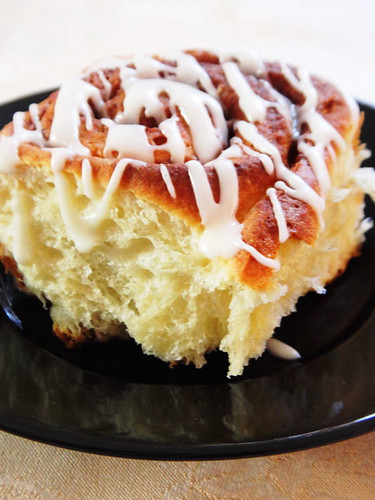
(from The Bread Baker’s Apprentice by Peter Reinhart)
Ingredients:
For the Cinnamon Buns
6½ tablespoons (100 ml) (3 oz) (90 gm) granulated sugar
1 teaspoon (5 ml) (6 gm) kitchen salt
5½ tablespoons (85 ml) (2¾ oz) (80 gm) unsalted butter or margarine, room temperature
1 large egg, slightly beaten at room temperature
1 teaspoon (5 ml) lemon extract or 1 teaspoon (5 ml) grated lemon zest
3½ cups (840 ml) (16 oz) (450 gm) unbleached bread (or all-purpose/plain) flour
2 teaspoons (10 ml) (¼ oz) (6 gm) instant yeast (or active dry yeast)
1 1/8 – 1 ¼ cups (270-300 ml) whole milk or buttermilk, room temperature
½ cup (120 ml) (3½ oz) (100 gm) cinnamon sugar
For the White Fondant Glaze
4 cups (500 gm) (17½ oz) of confectioners’ (icing) sugar
1 teaspoon (5 ml) of lemon or orange extract
6 tablespoons to ½ cup (90 to 120 ml) warm milk

Method:
- In a stand mixer fitted with the paddle attachment, cream together the sugar, salt and unsalted butter or margarine.
- Add the egg and lemon extract to the creamed sugar and unsalted butter/margarine and mix together until smooth.
- Add flour, yeast and milk to the mixer and mix on low speed until the mixture begins to form a rough ball of dough.
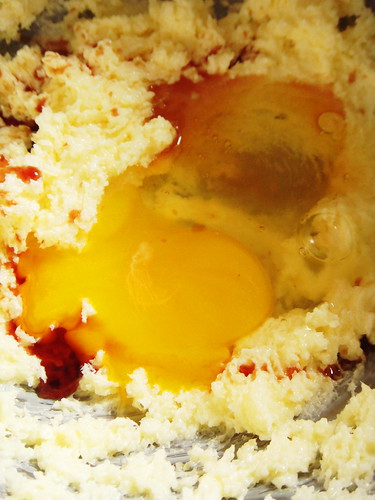
- At this point, switch to the dough hook attachment and knead for 10 minutes/ 12 to 15 minutes if kneading by hand.
- The dough will be silky and supple, but not overly sticky. You may need to add a touch of flour if dough is too sticky.
- Lightly oil a mixing bowl, turn the kneaded dough out into it, turning to coat, then cover the bowl with plastic wrap.
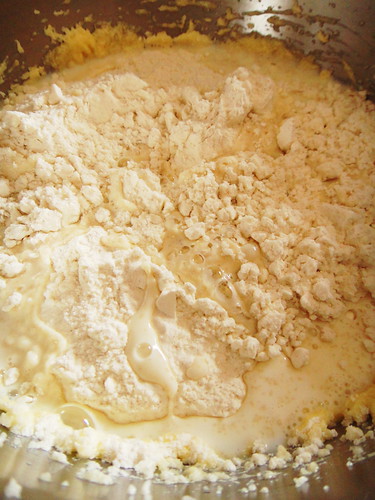
- Allow the dough to rest until it has doubled in size, approximately 2 hours. Line a sheet pan with parchment paper.
- Once dough has rested and risen, it is ready to be shaped into buns. Spray work surface lightly with cooking spray.
- Turn out dough onto work surface and roll out into a rectangle. Sprinkle with flour to keep the dough from sticking.
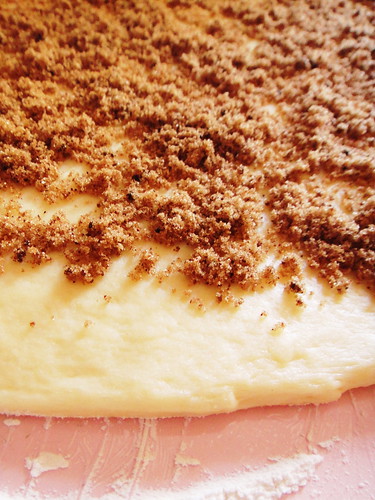
- It should be about 2/3 an inch (15 mm)thick, 14 inches (350 mm)wide and 12 inches (300 mm)long for large buns.
- For smaller cinnamon buns, roll dough out into a 18 inches (450 mm) wide by 9 inches (230 mm) long rectangle.
- Sprinkle cinnamon sugar filling over the surface of the dough. Starting with a long end, roll dough into a log shape.

- Make sure to end log with the seam side down. Cut the dough into pieces approximately 1¾ inches (45 mm) thick.
- For smaller buns, cut into 1¼ inch (30 mm) pieces. Place the buns approximately ½ inch (15 mm) apart on the pan.
- They should not be touching at this time. Allow the shaped buns to proof at room temperature for 75 to 90 minutes.
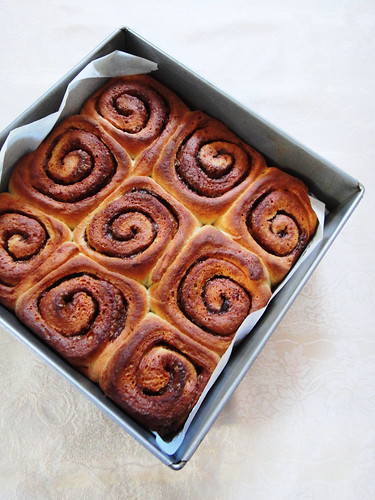
- They should nearly double in size and will now be touching each other. Preheat the oven to moderate 350°F/180°C.
- If you are not planning to bake on the same day, place buns in the refrigerator after they are shaped for up to 2 days.
- Bake the buns for 20 to 30 minutes, until golden brown. Allow to cool for 10 minutes in the pan before glazing them.

- For the white fondant glaze, sift the confectioners’ (icing) sugar into a large bowl and add the lemon or orange extract.
- Add milk in small amounts, whisking briskly until all the sugar has dissolved and the desired consistency is reached.
- Remove the buns from the pan to a cooling rack and drizzle with fondant glaze. Makes 8-12 large or 12-16 small buns.
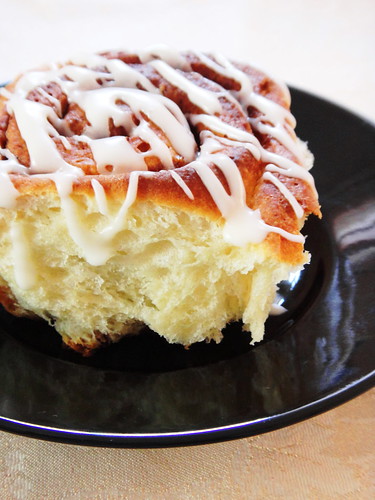
Storage & Freezing Instructions
Cinnamon rolls taste best fresh from the oven, but can be kept, covered tightly with plastic wrap or foil, at room temperature for a few days. To freeze the completed cinnamon rolls, wrap them individually first, either in plastic wrap or by placing each into its own plastic sandwich sized bag and closing it carefully, then place the individually wrapped rolls into a larger freezer bag or an airtight container and freeze for up to three months. This makes it very easy and convenient when you want to reheat one or two, as opposed to freezing the whole batch all together.





8 comments
Comments feed for this article
June 28, 2014 at 2:18 am
Korena in the Kitchen
Beautiful – thw crumb looks so light and airy!
June 28, 2014 at 6:48 am
prerrnamirchi
thanks Korena!
June 29, 2014 at 12:59 am
Shelley C
Your cinnamon buns look outstanding and your photos are beautiful. Wonderful job!
June 29, 2014 at 4:22 am
prerrnamirchi
Thank you Shelley! This month’s challenge was so much fun!
June 30, 2014 at 5:12 am
marcellina
Great tip for cutting the buns! I thought yours looked particularly neat!
July 1, 2014 at 12:00 pm
prerrnamirchi
Thank you Marcellina 🙂 It was really cool tip indeed!
July 4, 2014 at 7:57 am
What's for dessert?
Great tip for cutting the buns! They look perfect!
May 17, 2015 at 6:46 pm
La Fête du Pain 2015 – Coconut & Chocolate Chip Rolls | Heaven on a Spoon
[…] In keeping with the spirit of this international festival, I made my all-time favorite Cinnamon Rolls along with Coconut & Chocolate chip rolls from Creations by […]